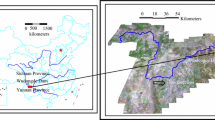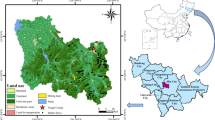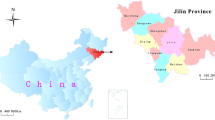Abstract
The selection of important factors in machine learning-based susceptibility assessments is crucial to obtain reliable susceptibility results. In this study, metaheuristic optimization and feature selection techniques were applied to identify the most important input parameters for map** debris flow susceptibility in the southern mountain area of Chengde City in Hebei Province, China, by using machine learning algorithms. In total, 133 historical debris flow records and 16 related factors were selected. The support vector machine (SVM) was first used as the base classifier, and then a hybrid model was introduced by a two-step process. First, the particle swarm optimization (PSO) algorithm was employed to select the SVM model hyperparameters. Second, two feature selection algorithms, namely principal component analysis (PCA) and PSO, were integrated into the PSO-based SVM model, which generated the PCA-PSO-SVM and FS-PSO-SVM models, respectively. Three statistical metrics (accuracy, recall, and specificity) and the area under the receiver operating characteristic curve (AUC) were employed to evaluate and validate the performance of the models. The results indicated that the feature selection-based models exhibited the best performance, followed by the PSO-based SVM and SVM models. Moreover, the performance of the FS-PSO-SVM model was better than that of the PCA-PSO-SVM model, showing the highest AUC, accuracy, recall, and specificity values in both the training and testing processes. It was found that the selection of optimal features is crucial to improving the reliability of debris flow susceptibility assessment results. Moreover, the PSO algorithm was found to be not only an effective tool for hyperparameter optimization, but also a useful feature selection algorithm to improve prediction accuracies of debris flow susceptibility by using machine learning algorithms. The high and very high debris flow susceptibility zone appropriately covers 38.01% of the study area, where debris flow may occur under intensive human activities and heavy rainfall events.
Similar content being viewed by others
Availability of Data/Materials: All relevant data are available on request from the corresponding author (https://orcid.org/0000-0001-5666-9860).
References
Al-Shabeeb AR, Al-Fugara AK, Khedher KM, et al. (2022) Spatial map** of landslide susceptibility in Jerash governorate of Jordan using genetic algorithm-based wrapper feature selection and bagging-based ensemble model. Geomat Nat Haz Risk 13(1): 2252–2282. https://doi.org/10.1080/19475705.2022.2112096
Alrefai N, Ibrahim O (2022) Optimized feature selection method using particle swarm intelligence with ensemble learning for cancer classification based on microarray datasets. Neural Comput Appl 34(16): 13513–13528. https://doi.org/10.1007/s00521-022-07147-y
Angillieri MYE (2020) Debris flow susceptibility map** using frequency ratio and seed cells, in a portion of a mountain international route, Dry Central Andes of Argentina. Catena 189: 104504. https://doi.org/10.1016/j.catena.2020.104504
Dash RK, Falae PO, Kanungo DP (2022) Debris flow susceptibility zonation using statistical models in parts of Northwest Indian Himalayas–implementation, validation, and comparative evaluation. Nat Hazards 111(2): 2011–2058. https://doi.org/10.1007/s11069-021-05128-3
Dhal P, Azad C (2022) A comprehensive survey on feature selection in the various fields of machine learning. Appl Intell 52: 4543–4581. https://doi.org/10.1007/s10489-021-02550-9
Dou J, Yunus AP, Bui DT, et al. (2020) Improved landslide assessment using support vector machine with bagging, boosting, and stacking ensemble machine learning framework in a mountainous watershed, Japan. Landslides 17: 641–658. https://doi.org/10.1007/s10346-019-01286-5
Fadhillah MF, Hakim WL, Panahi M, et al. (2022) Map** of landslide potential in Pyeongchang-gun, South Korea, using machine learning meta-based optimization algorithms. Egypt J Remote Sens Space Sci 25(2): 463–472. https://doi.org/10.1016/j.ejrs.2022.03.008
Gao Z, Ding M (2022) Application of convolutional neural network fused with machine learning modeling framework for geospatial comparative analysis of landslide susceptibility. Nat Hazards 113(2): 833–858. https://doi.org/10.1007/s11069-022-05326-7
Hu J, Zhao Y, Liu X, et al. (2010) Early Mesozoic deformations of the eastern Yanshan thrust belt, northern China. Int J Earth Sci 99: 785–800. https://doi.org/10.1007/s00531-009-0417-5
Huang F, Cao Z, Jiang SH, et al. (2020) Landslide susceptibility prediction based on a semi-supervised multiple-layer perceptron model. Landslides 17: 2919–2930. https://doi.org/10.1007/s10346-020-01473-9
Huqqani IA, Tay LT, Mohamad-Saleh J (2023) Spatial landslide susceptibility modelling using metaheuristic-based machine learning algorithms. Eng Comput-Germany 39(1): 867–891. https://doi.org/10.1007/s00366-022-01695-6
Kim SB, Rattakorn P (2011) Unsupervised feature selection using weighted principal components. Expert Syst Appl 38(5): 5704–5710. https://doi.org/10.1016/j.eswa.2010.10.063
Kumar A, Sarkar R (2023) Debris flow susceptibility evaluation–a review. IJST-T Civ Eng 47(3): 1277–1292. https://doi.org/10.1007/s40996-022-01000-x
Li L, Cheng S, Wen Z (2021) Landslide prediction based on improved principal component analysis and mixed kernel function least squares support vector regression model. J Mt Sci 18: 2130–2142. https://doi.org/10.1007/s11629-020-6396-5
Li W, Fang Z, Wang Y (2021) Stacking ensemble of deep learning methods for landslide susceptibility map** in the Three Gorges Reservoir area, China. Stoch Env Res Risk A 36: 2207–2228. https://doi.org/10.1007/s00477-021-02032-x
Liu K, Wang M, Cao Y, et al. (2018) Susceptibility of existing and planned Chinese railway system subjected to rainfall-induced multi-hazards. Transport Res A-Pol 117: 214–226. https://doi.org/10.1016/j.tra.2018.08.030
Liu Y, Chen J, Sun X, et al. (2024) A progressive framework combining unsupervised and optimized supervised learning for debris flow susceptibility assessment. Catena 234: 107560. https://doi.org/10.1016/j.catena.2023.107560
Lv J, Qin S, Chen J, et al. (2023) Application of different watershed units to debris flow susceptibility map**: A case study of Northeast China. Front Earth Sc-Switz 11: 1118160. https://doi.org/10.3389/feart.2023.1118160
Micheletti N, Foresti L, Robert S, et al. (2014) Machine learning feature selection methods for landslide susceptibility map**. Math Geosci 46: 33–57. https://doi.org/10.1007/s11004-013-9511-0
Pham BT, Van Dao D, Acharya TD, et al. (2021) Performance assessment of artificial neural network using chi-square and backward elimination feature selection methods for landslide susceptibility analysis. Environ Earth Sci 80: 1–13. https://doi.org/10.1007/s12665-021-09998-5
Polat A, Erik D (2020) Debris flow susceptibility and propagation assessment in West Koyulhisar, Turkey. J Mt Sci 17(11): 2611–2623. https://doi.org/10.1007/s11629-020-6261-6
Qiao SS, Qin SW, Sun JB, et al. (2021) Development of a region-partitioning method for debris flow susceptibility map**. J Mt Sci 18(5): 1177–1191. https://doi.org/10.1007/s11629-020-6497-1
Qin S, Qiao S, Yao J, et al. (2022) Establishing a GIS-based evaluation method considering spatial heterogeneity for debris flow susceptibility map** at the regional scale. Nat Hazards 114(3): 2709–2738. https://doi.org/10.1007/s11069-022-05487-5
Qiu C, Su L, Zou Q, et al. (2022) A hybrid machine-learning model to map glacier-related debris flow susceptibility along Gyirong Zangbo watershed under the changing climate. Sci Total Environ 818: 151752. https://doi.org/10.1016/j.scitotenv.2021.151752
Shafizadeh-Moghadam H, Tayyebi A, Ahmadlou M, et al. (2017) Integration of genetic algorithm and multiple kernel support vector regression for modeling urban growth. Comput Environ Urban 65: 28–40. https://doi.org/10.1016/j.compenvurbsys.2017.04.011
Uğuz H (2011) A two-stage feature selection method for text categorization by using information gain, principal component analysis and genetic algorithm. Knowl-Based Syst 24(7): 1024–1032. https://doi.org/10.1016/j.knosys.2011.04.014
Wu S, Chen J, Zhou W, et al. (2019) A modified logit model for assessment and validation of debris-flow susceptibility. B Eng Geol Environ 78: 4421–4438. https://doi.org/10.1007/s10064-018-1412-5
Zhang YB, Xu PY, Liu J, et al. (2023) Comparison of LR, 5-CV SVM, GA SVM, and PSO SVM for landslide susceptibility assessment in Tibetan Plateau area, China. J Mt Sci 20: 979–95. https://doi.org/10.1007/s11629-022-7685-y
Zhao S, Zhao Z (2021) A comparative study of landslide susceptibility map** using SVM and PSO-SVM models based on Grid and Slope Units. Math Probl Eng 2021: 1–15. https://doi.org/10.1155/2021/8854606
Zhao Y, Meng X, Qi T, et al. (2020) AI-based identification of low-frequency debris flow catchments in the Bailong River basin, China. Geomorphology 359: 107125. https://doi.org/10.1016/j.geomorph.2020.107125
Acknowledgments
This research was supported by the Second Tibetan Plateau Scientific Expedition and Research Program (Grant no. 2019QZKK0904), Natural Science Foundation of Hebei Province (Grant no. D2022403032), and S&T Program of Hebei (Grant no. E2021403001). The authors are highly indebted to the data provider, the anonymous reviewers, and the editors, who significantly improved the quality of the paper.
Author information
Authors and Affiliations
Contributions
All authors contributed to the implementation process of this study. ZHAO Haijun: Methodology, Validation, Writing-review & editing. WEI Aihua: Methodology, Software, Writing-original draft. MA Fengshan: Supervision, Formal analysis, Writing-review & editing. DAI Fenggang: Investigation, Validation. JIANG Yongbing: Visualization, Investigation. LI Hui: Investigation, Resources.
Corresponding author
Ethics declarations
Conflict of Interest: The authors declare no conflicts of interest.
Rights and permissions
About this article
Cite this article
Zhao, H., Wei, A., Ma, F. et al. Comparison of debris flow susceptibility assessment methods: support vector machine, particle swarm optimization, and feature selection techniques. J. Mt. Sci. 21, 397–412 (2024). https://doi.org/10.1007/s11629-023-8395-9
Received:
Revised:
Accepted:
Published:
Issue Date:
DOI: https://doi.org/10.1007/s11629-023-8395-9




